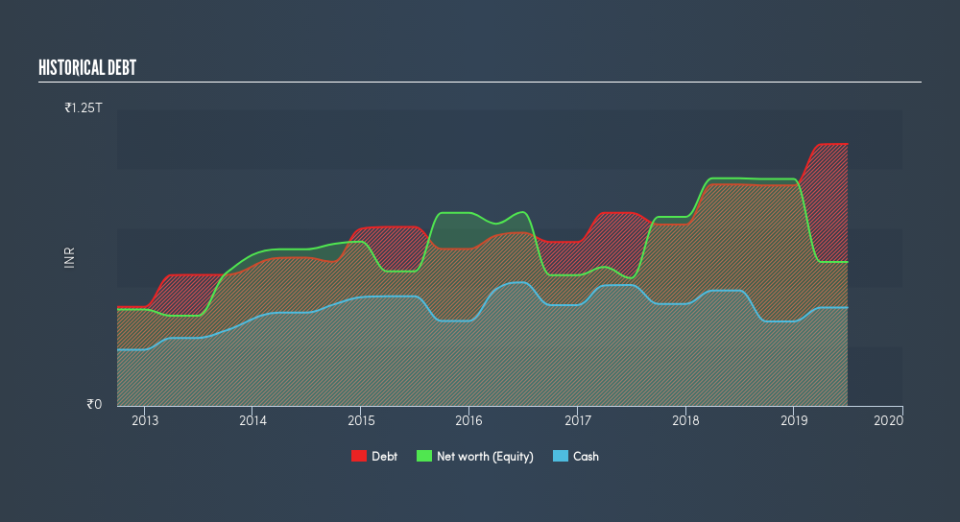Tata Motors (NSE:TATAMOTORS) Has A Mountain Of Debt

Howard Marks put it nicely when he said that, rather than worrying about share price volatility, 'The possibility of permanent loss is the risk I worry about... and every practical investor I know worries about.' When we think about how risky a company is, we always like to look at its use of debt, since debt overload can lead to ruin. We note that Tata Motors Limited (NSE:TATAMOTORS) does have debt on its balance sheet. But the more important question is: how much risk is that debt creating?
When Is Debt Dangerous?
Generally speaking, debt only becomes a real problem when a company can't easily pay it off, either by raising capital or with its own cash flow. If things get really bad, the lenders can take control of the business. However, a more usual (but still expensive) situation is where a company must dilute shareholders at a cheap share price simply to get debt under control. Of course, debt can be an important tool in businesses, particularly capital heavy businesses. When we think about a company's use of debt, we first look at cash and debt together.
See our latest analysis for Tata Motors
What Is Tata Motors's Net Debt?
As you can see below, at the end of March 2019, Tata Motors had ₹1.10t of debt, up from ₹933.7b a year ago. Click the image for more detail. On the flip side, it has ₹414.8b in cash leading to net debt of about ₹689.4b.
How Strong Is Tata Motors's Balance Sheet?
We can see from the most recent balance sheet that Tata Motors had liabilities of ₹1.45t falling due within a year, and liabilities of ₹1.01t due beyond that. On the other hand, it had cash of ₹414.8b and ₹258.5b worth of receivables due within a year. So its liabilities outweigh the sum of its cash and (near-term) receivables by ₹1.79t.
This deficit casts a shadow over the ₹461.0b company, like a colossus towering over mere mortals. So we'd watch its balance sheet closely, without a doubt After all, Tata Motors would likely require a major re-capitalisation if it had to pay its creditors today.
In order to size up a company's debt relative to its earnings, we calculate its net debt divided by its earnings before interest, tax, depreciation, and amortization (EBITDA) and its earnings before interest and tax (EBIT) divided by its interest expense (its interest cover). The advantage of this approach is that we take into account both the absolute quantum of debt (with net debt to EBITDA) and the actual interest expenses associated with that debt (with its interest cover ratio).
While Tata Motors's debt to EBITDA ratio (4.5) suggests that it uses debt fairly modestly, its interest cover is very weak, at 0.68. It seems that the business incurs large depreciation and amortisation charges, so maybe its debt load is heavier than it would first appear, since EBITDA is arguably a generous measure of earnings. So shareholders should probably be aware that interest expenses appear to have really impacted the business lately. Even worse, Tata Motors saw its EBIT tank 75% over the last 12 months. If earnings keep going like that over the long term, it has a snowball's chance in hell of paying off that debt. When analysing debt levels, the balance sheet is the obvious place to start. But it is future earnings, more than anything, that will determine Tata Motors's ability to maintain a healthy balance sheet going forward. So if you're focused on the future you can check out this free report showing analyst profit forecasts.
Finally, a business needs free cash flow to pay off debt; accounting profits just don't cut it. So it's worth checking how much of that EBIT is backed by free cash flow. During the last three years, Tata Motors burned a lot of cash. While investors are no doubt expecting a reversal of that situation in due course, it clearly does mean its use of debt is more risky.
Our View
To be frank both Tata Motors's EBIT growth rate and its track record of staying on top of its total liabilities make us rather uncomfortable with its debt levels. And furthermore, its interest cover also fails to instill confidence. It looks to us like Tata Motors carries a significant balance sheet burden. If you play with fire you risk getting burnt, so we'd probably give this stock a wide berth. Even though Tata Motors lost money on the bottom line, its positive EBIT suggests the business itself has potential. So you might want to check outhow earnings have been trending over the last few years.
At the end of the day, it's often better to focus on companies that are free from net debt. You can access our special list of such companies (all with a track record of profit growth). It's free.
We aim to bring you long-term focused research analysis driven by fundamental data. Note that our analysis may not factor in the latest price-sensitive company announcements or qualitative material.
If you spot an error that warrants correction, please contact the editor at editorial-team@simplywallst.com. This article by Simply Wall St is general in nature. It does not constitute a recommendation to buy or sell any stock, and does not take account of your objectives, or your financial situation. Simply Wall St has no position in the stocks mentioned. Thank you for reading.

